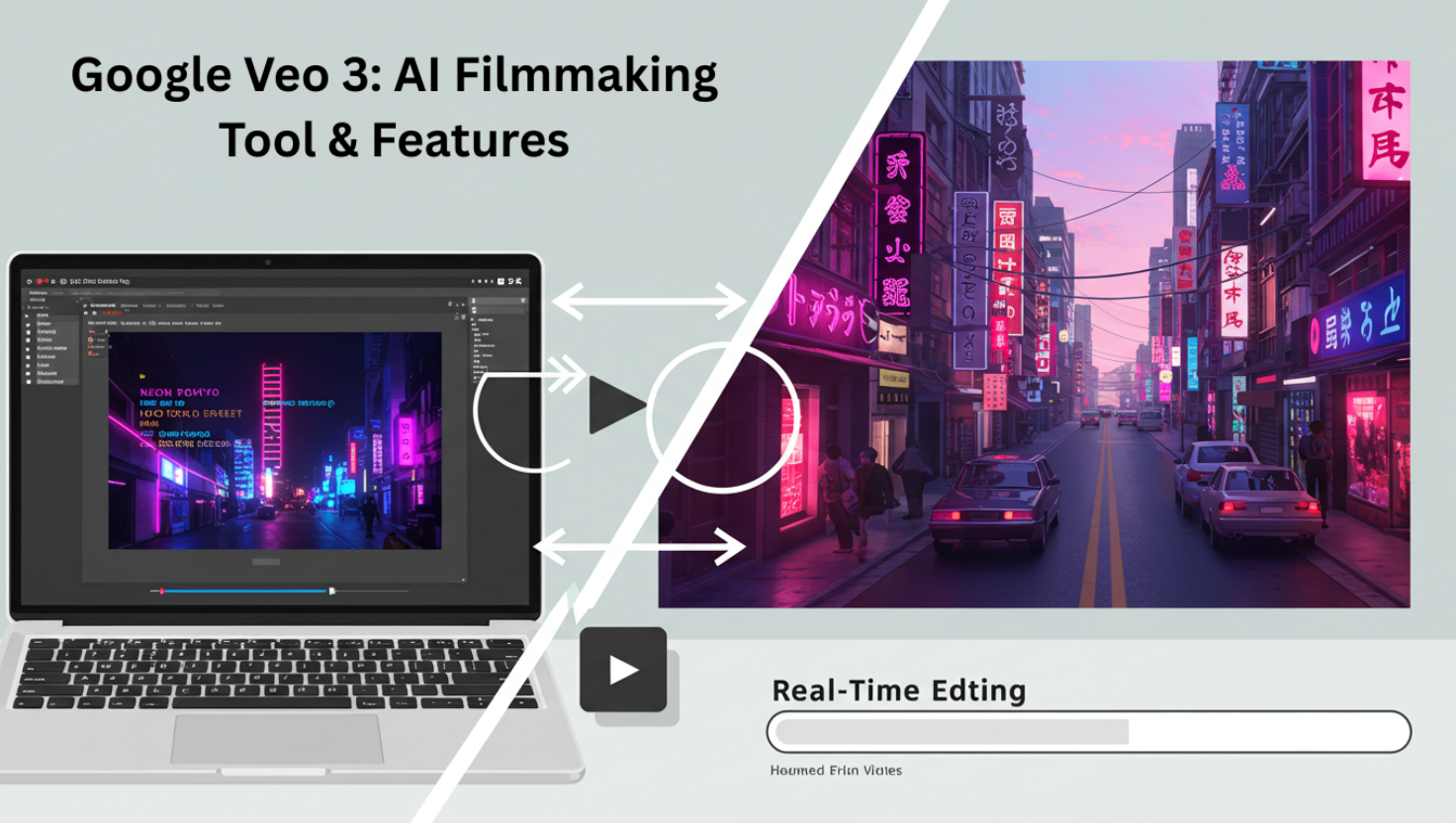Google’s Veo 3 has emerged as a groundbreaking AI filmmaking tool, redefining how creators produce high-quality videos. Leveraging advanced text-to-video AI, Veo 3 empowers filmmakers, marketers, and content creators to generate cinematic content in minutes. With expanded global availability and enhanced features like 4K resolution and real-time editing, Google Veo 3 positions itself as a leader in AI-driven creative tools. This article explores its capabilities, usability, and impact on the future of filmmaking.
What is Google Veo 3?
Veo 3, developed by Google’s DeepMind team, is an AI-powered filmmaking tool designed to streamline video production. Using natural language prompts, users can generate dynamic videos, edit scenes in real time, and export professional-grade 4K content. Built on multimodal AI architecture, Veo 3 interprets context, emotions, and visual styles, making it a versatile asset for storytelling.
Key Features of Google Veo 3
1. Text-to-Video Generation
Convert descriptive prompts into high-fidelity videos. Example: Input “sunset over mountains with eagles soaring” to generate a 10-second clip.
2. 4K Ultra-HD Resolution
Export videos in cinematic 4K, ideal for commercial projects and social media.
3. Real-Time Editing Suite
Adjust lighting, add transitions, or modify scenes without re-rendering.
4. Multilingual Support
Create videos in 15+ languages, broadening global creative reach.
5. Ethical AI Safeguards
Built-in filters to prevent misuse, ensuring compliance with Google’s AI ethics guidelines.
How to Use Veo 3 for AI Filmmaking: A Step-by-Step Guide
1. Access the Platform
Visit Google’s AI Studio or partner platforms like YouTube Create.
2. Input Text Prompts
Describe scenes in detail (e.g., “a bustling Tokyo street at night in neon lights”).
3. Customize Parameters
Select video length (5–60 seconds), aspect ratio, and style (animated, realistic).
4. Edit with AI Tools
Use the drag-and-drop editor to refine transitions, audio sync, or color grading.
5. Export & Share
Download in MP4 or MOV formats or publish directly to social platforms.
Veo 3’s Expanded Global Availability
Google has rolled out Veo 3 to 30+ new countries, including India, Brazil, and Nigeria. Key updates:
- Localized Templates: Culturally relevant themes for festivals, traditions, and trends.
- Regional Language Support: Hindi, Portuguese, and Arabic prompts now accepted.
- Collaboration Tools: Partner with local creators via Google Workspace integration.
Why Veo 3 is a Game-Changer for Filmmakers
- Cost Efficiency: Reduce production costs by 70% compared to traditional methods.
- Speed: Generate storyboards or B-roll in seconds.
- Accessibility: Novice-friendly interface with pro-level outputs.
- Scalability: Ideal for indie creators and agencies alike.
Google Veo 3 Pricing: Plans and Accessibility
While Google has not yet released official pricing details for Veo 3, its structure aligns with Google’s AI tool monetization strategies and competitor models like OpenAI’s Sora or Runway ML. Based on the DataCamp tutorial and Google’s blog, here’s what creators can expect:
1. Freemium Tier (Basic)
Cost: Free with usage limits.
Features:
- 5 video generations/month (up to 10 seconds each).
- 1080p resolution exports.
- Access to basic editing tools and 5 pre-built templates.
- Watermarked outputs for non-commercial use.
Ideal For: Hobbyists, students, or small creators testing AI video tools.
2. Pro Tier (Subscription-Based)
Estimated Cost: $20–$50/month (based on Google’s Workspace pricing).
Features:
- 50 video generations/month (up to 60 seconds each).
- 4K resolution exports.
- Advanced editing tools (real-time collaboration, custom transitions).
- Commercial licensing for social media and ads.
- Priority customer support.
Ideal For: Freelancers, marketers, and indie filmmakers.
3. Enterprise Tier (Custom)
Cost: Custom quotes based on usage scale.
Features:
- Unlimited video generations and rendering.
- Dedicated AI training for brand-specific styles.
- API integration for CMS platforms like WordPress or Shopify.
- Enhanced security and team management via Google Cloud.
Ideal For: Agencies, studios, and large-scale production teams.
Factors Influencing Veo 3’s Pricing
- Video Length: Longer clips (30–60 seconds) may consume more credits.
- Resolution: 4K exports are likely reserved for paid tiers.
- Commercial Use: Royalty-free licensing could require Pro/Enterprise plans.
- Regional Adjustments: Pricing may vary in newly supported countries (e.g., India, Brazil)
How Veo 3 Compares to Competitors
- OpenAI Sora: Estimated $0.02–$0.05/second of video (no public access yet).
- Runway ML: $15–$95/month for similar AI video tools.
- Synthesia: $30–$1,000+/month for avatar-based videos.
The Future of AI Filmmaking with Veo 3
Google plans to integrate Veo 3 with Gemini AI for multi-scene narratives and VR/AR compatibility. Analysts predict AI tools like Veo 3 will dominate 40% of digital content by 2026, reshaping industries from advertising to education.
Conclusion:
Google’s Veo 3 sets a new standard for AI filmmaking, blending innovation with practicality. Whether you’re crafting marketing campaigns or indie films, Veo 3’s text-to-video prowess, global reach, and ethical framework make it indispensable. Stay ahead in the creative revolution. explore Veo 3 today.

